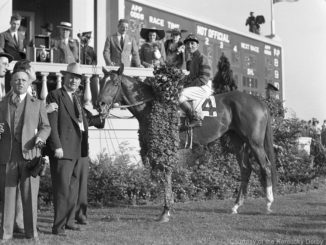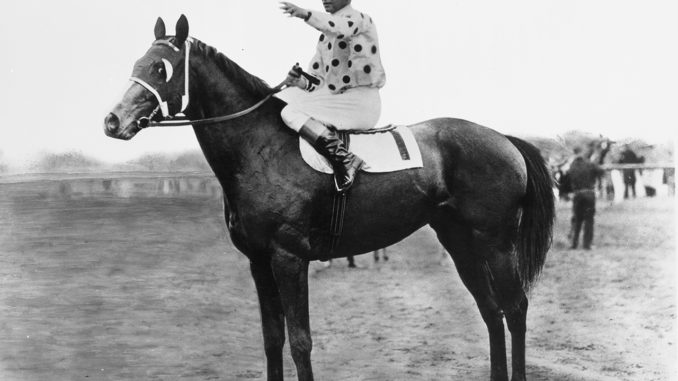
Gallant Fox — 1930 Triple Crown winner
Since the days of the Homeric epics, games and athletic contests have been held in honor of departed heroes. In our contemporary racing world, we do something similar in naming stakes races after past champions. Such races provide opportunities to recall the deeds of their namesakes, which can illustrate the rich connections between past and present that shape our sport. In this spirit, we begin the first in a series of “Historical Cameos.” Originally available Jan. 3, 2006.
America’s (and unofficially the world’s) leading money winner for a time, widely regarded in his day as the best since Man o’War.
Aqueduct honored the memory of 1930 Triple Crown winner Gallant Fox with the $83,100 stakes run in his name. Today’s racing media ritually conjures up the ghost of Gallant Fox every August, only to inflict upon him the indignity of remembering his most spectacular failure, his crushing loss in the Travers mire at the hands of 100-1 shot Jim Dandy.

It’s one of life’s little ironies that the Saratoga stakes commemorating Jim Dandy, who did precious little else in his career, holds a much more significant spot on the racing calendar than the one honoring Gallant Fox, the supremo of his generation, America’s (and unofficially the world’s) leading money winner for a time, widely regarded in his day as the best since Man o’War.
| Gallant Fox Pedigree | ||
|---|---|---|
| *Teddy | ||
| *Sir Gallahad III (FR) | ||
| =Plucky Liege (GB) | ||
| Gallant Fox | ||
| Celt | ||
| Marguerite (1920) | ||
| *Fairy Ray |
A homebred racing for William Woodward Sr.’s Belair Stud, Gallant Fox was sired by the imported French stallion *Sir Gallahad III and produced by Marguerite (Celt). Under the tutelage of legendary horseman “Sunny Jim” Fitzsimmons, Gallant Fox captured two stakes from seven starts at two, but the handsome bay was bred to reach the peak of his powers over classic distances at three, and so he did. Expecting that great things lay ahead, gifted jockey Earl Sande, a two-time Kentucky Derby winner, came out of retirement to partner the colt in 1930.
After hacking up by four easy lengths in the Wood Memorial, his three-year-old debut, Gallant Fox invaded Pimlico for the Preakness S., run before the Kentucky Derby that year. After being cut off by a rival and boxed in traffic on the first turn with Sande nearly standing in the irons, he made an explosive middle move to vault into contention, and in the stretch, he collared Crack Brigade and won going away by three-quarters of a length. Eight days later in the Kentucky Derby, Gallant Fox took control of affairs by the time they’d traveled a half-mile and posted a comfortable two length victory while under wraps, his foes struggling under stiff drives in his wake.
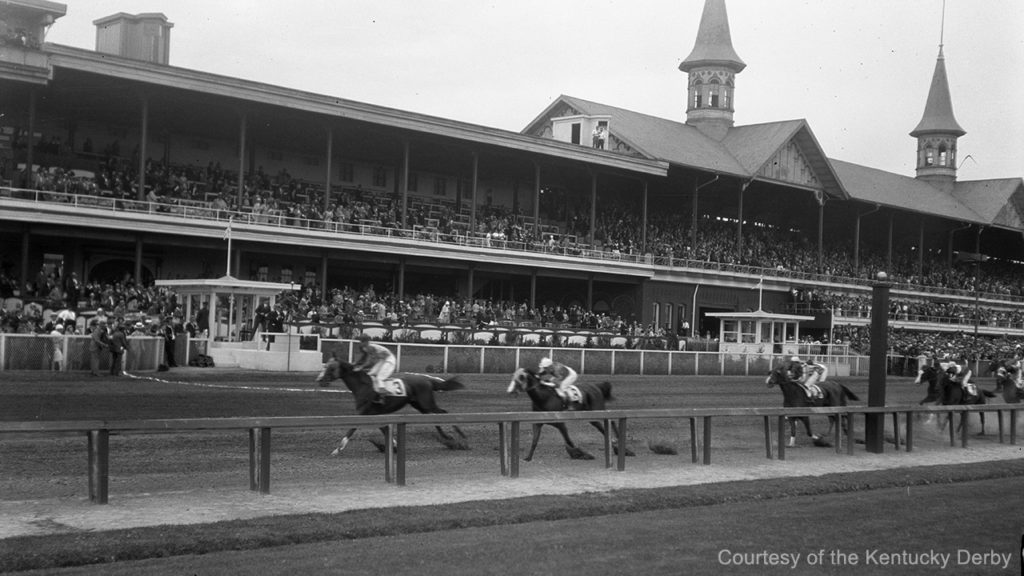
The Fox of Belair
The “Fox of Belair,” as he was dubbed, then faced a showdown with 1929 champion two-year-old Whichone in the Belmont S. Sande drove his mount to the lead right after the break and never looked back. In a tour de force performance, Gallant Fox dismissed Whichone by three lengths, proving that while Whichone had enjoyed the advantage during the Fox’s immature juvenile days, the tables had been comprehensively turned at three.
Gallant Fox thus became the second Triple Crown winner in chronological terms, with Sir Barton the first to sweep the Kentucky Derby, Preakness and Belmont in 1919. But the Fox was the first to be recognized as having achieved this special feat in his own day, by noted turf writer Charles Hatton, whereas Sir Barton was recognized only in retrospect.
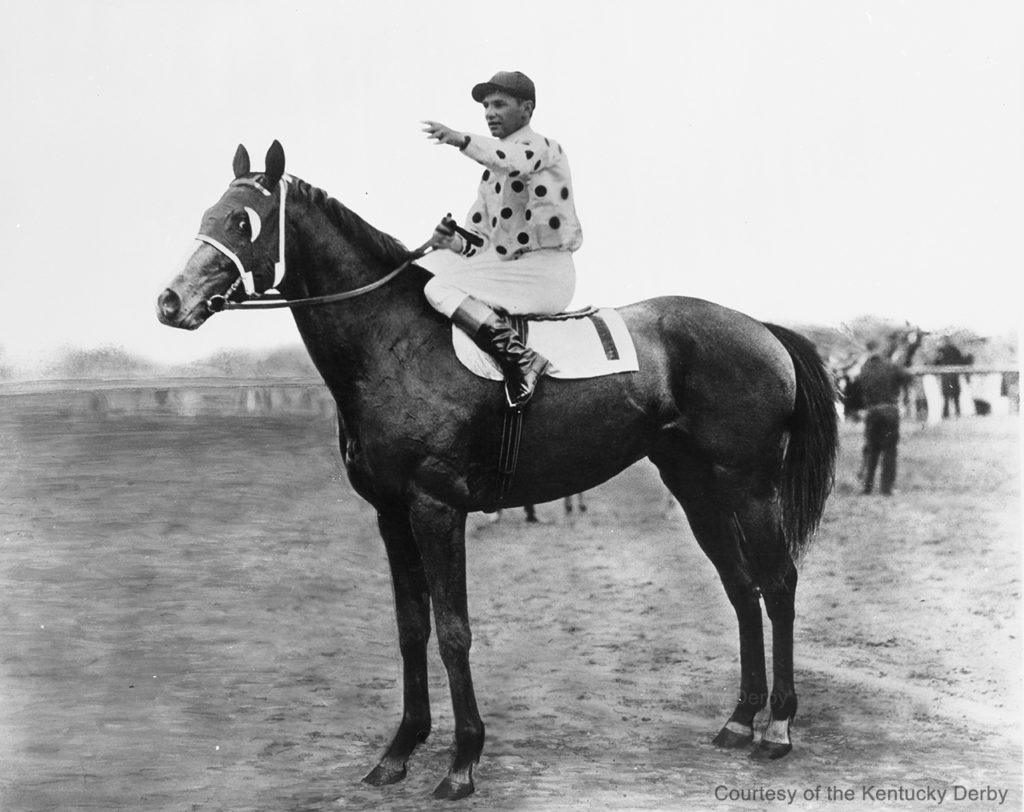
Fitzsimmons continued to run his charge, and the Fox duly responded with victories in the Dwyer S. (then staged over 1 1/2 miles at Aqueduct) and the Classic S. at Arlington Park. Having won six prestigious races in a row at three, the Belair star lined up in that fateful Travers. He and archrival Whichone engaged in a suicidal speed duel in the heavy and tiring mud, destroying each other’s chances while opening the door to the mudlark Jim Dandy, who sailed to an improbable victory of Arcangues-like proportions. Gallant Fox held second, but Whichone literally cracked under the pressure, breaking down never to race again. The Fox brushed aside that loss, his only reverse in 10 starts at three, to score against older horses in the Saratoga Cup.
RELATED: They called him Mr. Fitz: remembering Hall of Famer Sunny Jim Fitzsimmons
It is fitting that Aqueduct cards the Gallant Fox H. at 1 5/8 miles, although a relic by today’s standards, because that was the distance of perhaps his noblest victory. In the Lawrence Realization S., the Fox and classy front-runner Questionnaire staged an epic duel through the stretch, each colt seeming to hold the advantage at turns, but with the other then fighting and coming again. They each broke the American record for the 1 1/2-mile split, accomplished in 2:28 2/5, before Gallant Fox dug deep to force his head in front at the wire in 2:41 1/5, the closest any horse had yet come to Man o’War’s 1 5/8-mile record. The Fox’s career finale was an anticlimactic three-length win against two opponents in the 2-mile Jockey Club Gold Cup S. The laconic chart comment for that race, and for several others, read simply, “Speed in reserve.”
Over the course of his career, Gallant Fox won 11 of 17 starts, was second three times, and third twice, his lone off-the-board finish occurring in his two-year-old year. He set a single-season earnings record by raking in $308,275 in 1930, a mark that stood for 16 years. The Fox briefly held the American record for lifetime earnings with $328,165. While the French titan, *Ksar, officially held the world lifetime mark of $335,340, his totals reflect the value of trophies won as well as breeders’ awards, not just purse money. If recalculated according to the European system, Gallant Fox’s total would have eclipsed *Ksar’s.
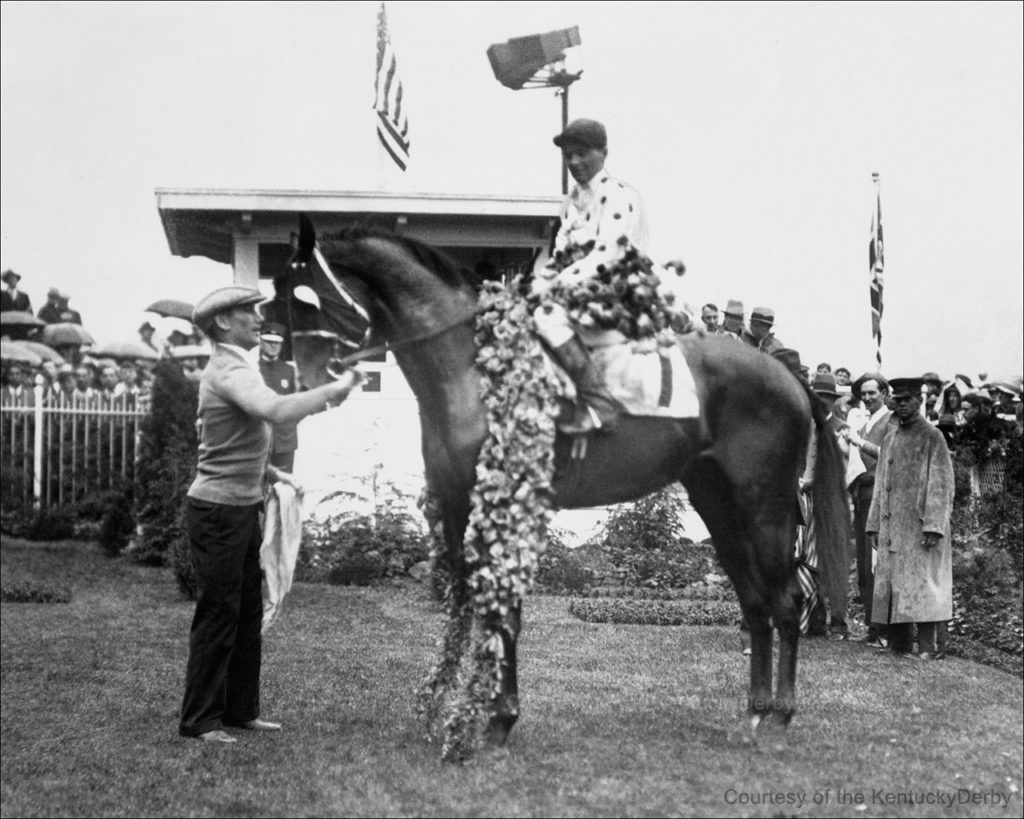
Retired to stud at Claiborne Farm near Paris, Kentucky, Gallant Fox got off the mark quickly by siring three outstanding performers from his first two crops — 1936 Horse of the Year Granville, who won the Belmont and avenged his sire’s loss in the Travers; Flares, who flew the flag for America in England, scoring in the 1937 Champion S. and 1938 Ascot Gold Cup; and most notably, Flares’ full brother, Omaha, who emulated his sire by winning the Triple Crown in 1935. Gallant Fox thus holds the distinction of being the only Triple Crown winner to sire a Triple Crown winner, and he will remain the only member of this club for a long time to come.
…And, through a daughter, Gallant Fox is hidden deep within the pedigree of 1978 Triple Crown hero Affirmed….
Although the Fox proved disappointing as a sire after those two golden crops, his name is still ensconced in the recesses of modern pedigrees. Omaha figures in the maternal side of the pedigree of the immortal Nijinsky II, the last winner of the English Triple Crown in 1970. Flares appears in the pedigree of Storm Bird, hence in the ancestry of the entire Storm Cat tribe as well. And, through a daughter, Gallant Fox is hidden deep within the pedigree of 1978 Triple Crown hero Affirmed.
Gallant Fox died in 1954, and three years later, he was enshrined in the National Museum of Racing and Hall of Fame.


